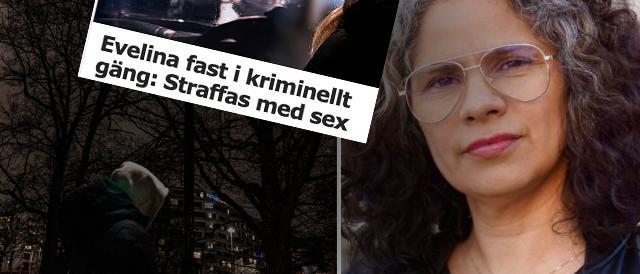unsaveSave
There is talk about the criminal gangs all the time.
But not about the girls, says Sofia Liedberg, who is operations manager at the Fria youth center in Eskilstuna.
– Who should be responsible?
This weekend, Aftonbladet told about Evelina, who is stuck in a criminal gang.
She got into it as a teenager – when it was hard at home, she found the boys with high status instead. In the beginning it was just exciting, but it wasn’t long before the gang started exploiting, threatening and forcing Evelina to do as they said.
expand-left
full screenEvelina has lived in the gang criminal world since her teens. The woman in the picture has nothing to do with the article. Photo: Carolina Byrmo
Sofia Liedberg is operations manager at Ungdomsjouren Fria in Eskilstuna. In her job, she meets girls who are attracted to the gang-criminal guys in a similar way.
Eskilstuna is one of several cities in Sweden that has been affected by serious violence and gang crime. For example, when there has been a shooting, the youth center has had support conversations with people who were close to those involved.
– Then there is this group of girls who partly glorify crime. You talk about looking up to these guys. You think that if your partner is in this, he can protect me. “Then he is a real man”. These stereotypical norms are reinforced.
Talking to the girls
Ungdomsjouren Fria works a lot to help the girls who approach the gangs to think in a different way.
– We generally talk norm-critical and gender-critical and about identifying warning signals. Why is this seen as something positive? Why do we think that jealousy is something that shows that you like someone?
expand-left
full screenSofia Liedberg, director of operations at Ungdomsjouren Fria in Eskilstuna. Photo: Private
But an even greater challenge for the girls’ emergency services is to reach those who are already involved in gang crime.
– They live under constant threats and may not come to us because of the risk of being discovered. We have started by allowing you to write in an anonymous chat, it is a way to overcome the biggest obstacles.
Are you prepared to help girls living in gang crime?
– Currently, I would say that we are not equipped for that. That can definitely be a problem. So far we have been quite spared.
The boys are in focus
Although the girls’ and women’s shelters are used to helping abused women, there is another vulnerability for the girls who live in criminal gangs, explains Sofia Liedberg.
The violence is rougher and the threat picture is greater.
expand-left
full screenEvelina today wants to break completely with the criminal life. The woman in the picture has nothing to do with the article. Photo: Carolina Byrmo
– We would need to know much more about how the municipality works with this. In all contexts where this is raised, it is only from the perspective of being a guy. And of course they are overrepresented. But I haven’t been in a single collaboration forum where the girls are lifted up in this, says Sofia Liedberg.
– We are a non-profit association. Who should be responsible?
“Glamourous world on the surface”
Criminologist Camila Salazar Atías, who works with young people at Fryshuset in Stockholm, thinks that in recent years the police have become better at spotting the girls in the criminal gangs.
expand-left
full screen Camila Salazar Atías, Head of Knowledge Area at Fryshuset. Photo: Fryshuset
– More girls come under scrutiny, more girls are arrested and end up in the correctional system.
But she believes that society does not look at the girls and women with the right glasses.
– The girls are around the boys, with the boys. We rarely talk about the girls as gang members. If social services bring in a girl seeking help, what questions do they ask? Do they get the same questions as the guys? Or are they sorted into support linked to violence in a close relationship? Is this why we so rarely see women in our dropout programs?
– I would like there to be an awareness so that questions were asked that also fished for gang affiliation. So they get access to an equivalent support.
When it comes to the preventive work, Camila Salazar Atías, just like Sofia Liedberg, believes that the most important thing is that the girls also gain knowledge about basic values and masculinity norms.
– To pierce the romanticized image and understand that on the surface it is a glamorous world but an extremely destructive world behind the surface, where it is very empty. It is important to understand that this loyalty and glamor is very temporary.
FACT So you can get help to quit
For urgent matters, always call 112.
For those of you who want to leave the criminal life behind you or have a relative, there are different ways to go.
Here are others you can turn to for help:
Read more
